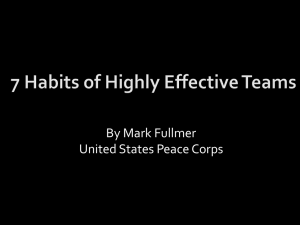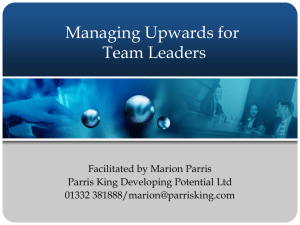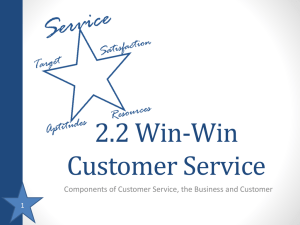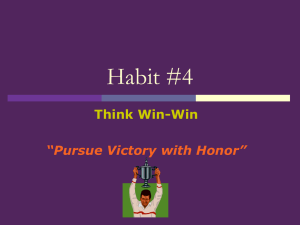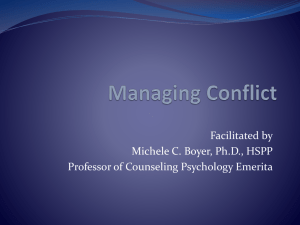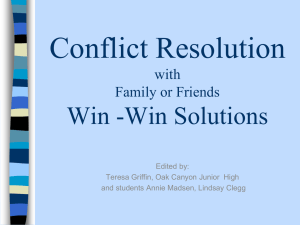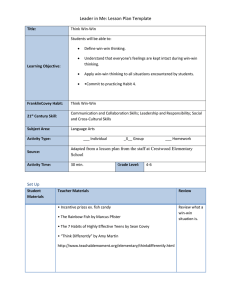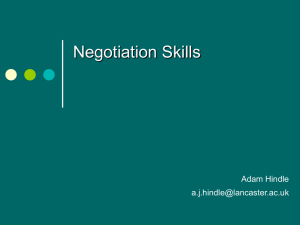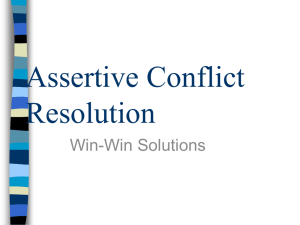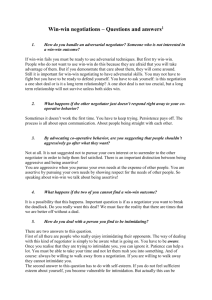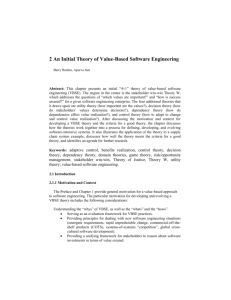Conflict
advertisement
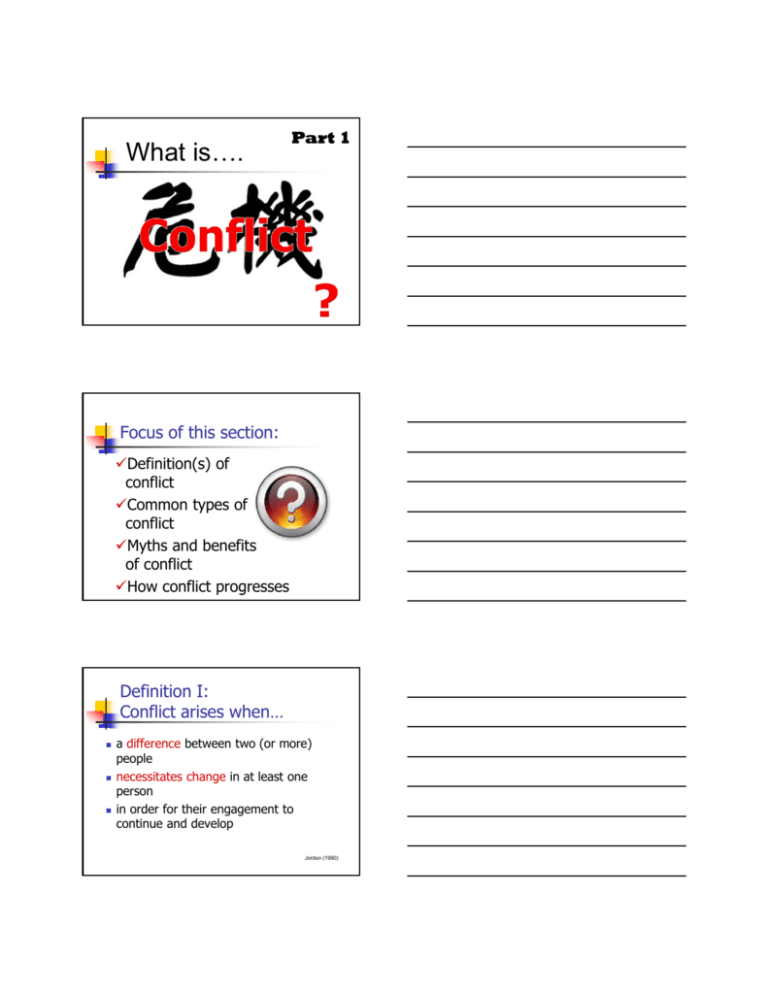
What is…. Part 1 Focus of this section: Definition(s) of conflict Common types of conflict Myths and benefits of conflict How conflict progresses Definition I: Conflict arises when… a difference between two (or more) people necessitates change in at least one person in order for their engagement to continue and develop Jordon (1990) Definition II: Conflict is…. People have to differ about something The difference has to upset one or both of them Difference Discomfort A Discomforting Difference Dues (1996) Types of Conflict Intrapersonal vs. Interpersonal Conflict – conflict within yourself vs. conflict between people. Pseudo Conflict – lack of understanding (AKA “false” conflict) Simple Conflict – real differences in ideas, definitions, perceptions, and goals Ego Conflict – the focus is on the person, not the behavior or the issue Definition III: Conflict is… An expressed struggle between... at least two interdependent parties who perceive incompatible goals scarce resources, and interference from the other party in achieving those goals Hocker & Wilmot (2001) Conflict Myths Is always bad Can always be avoided Is always due to misunderstandings (pseudo conflict) Is always a sign of a poor interpersonal relationship Can always be resolved Benefits of Conflict Focuses attention on problems requiring solving Clarifies potential changes Identifies important issues to involved parties You learn about you and your values (and your partner and his/her values) Strengthens relationships when conflict management attempts are successful Keeps relationships interesting How does Conflict progress? Source Prior Conditions Beginning Frustration Awareness Middle Active Conflict End Resolution/ Management Aftermath Follow-up Sources of Conflict Goals Personality Conflicts Scarce Resources Styles Values Processing Time! Which definition of conflict best exemplifies your view of conflict? From your perspective, which conflict myth is the most accepted by those closest to you? Thinking about your most recent conflict, what was the primary source of the conflict? What is…. Part 2 Focus of this section: Conflict-Management Styles Differences between Compromise and Collaboration Abraham Maslow Law of the Hammer “If the only tool you have is a hammer, you tend to see every problem as a nail.” 1974 Styles & Tactics Matrix The Thomas-Kilmann Conflict Mode Instrument High Concern for OWN Needs & Goals Being Met Low High Concern for OTHER’S Needs & Goals Being Met Review: Standard Conflict Management Strategies Competitive Collaborative High (Win/Lose) Concern for OWN Needs & Goals Being Met (Win/Win) Compromise (Lose/Lose) (Win/Lose, Lose/Win) Avoidance Accommodation (Lose/Lose) Low (Lose/Win) Concern for OTHER’S Needs & Goals Being Met High Concern for the relationship helps determine which to use High Competitive Concern for OWN Needs & Goals Being Met Collaborative Compromise Avoidance Low Accommodation High Concern for OTHER’S Needs & Goals Being Met Difference between Compromise & Collaboration Compromise Focuses on positions Each side gives up something important (not always 50/50) Come in with a specific solution in mind Often involves “turn taking” in solutions Collaboration Focuses on interests Both work together to help address each other’s interests Create a mutual solution Often simultaneous activity in solutions How to Work Towards a “Win-Win” solution (…in brief) Identify your problem & unmet needs Make a date to discuss it Describe your problem & needs Consider your partner’s point of view Negotiate a solution Follow up on a solution Quiz/Processing Time! What conflict management style involves both parties “giving up” an important part of their position? Which style is your primary method of managing conflict? Which conflict management style is the best method for all conflict situations? 7 Ways to Win a Conflict (but lose a relationship) Gunnysacking Personal attacks Issue expansion Crucializing Outside comparisons Bulldozing High belt lines Working Towards a “Win-Win” Preparation Discussion Problem Analysis SolutionGeneration Self Set up Expectations Discuss issue Brainstorm options Issue Manage yourself Establish interests Evaluate options BATNA Manage Information Possible constraints Negotiate solution Plan message Obtain commitment Set Date Follow up on solution Working Towards a “Win-Win” Preparation Look to yourself first Manage your emotions Identify your problem & unmet needs Be aware of what you are feeling Determine the underlying causes of what you are feeling Determine whether to express your anger Establish BATNA Plan your message Make a date with other to discuss it Working Towards a “Win-Win” Discussion Set up expectations Establish rapport (manage primary tension) Express positive feelings for outcome Establish ground rules for discussion Manage Yourself Breathe Monitor nonverbal messages Avoid disconfirming responses Use Self-Talk How to Work a “Win-Win” Discussion (cont.) Manage Information Describe your problem & needs Allow your partner to express point of view Ensure you understand Be descriptive & objective Own your feelings Listen effectively (consider nonverbal) Paraphrase Ask questions Focus on analysis & interests not solutions How to Work a “Win-Win” Problem Analysis Define/Describe/Analyze problem Establish interests/goals Yours & theirs NOT SOLUTIONS “I want [SOLUTION] because [INTEREST] Identify possible constraining factors How to Work a “Win-Win” Solutions Brainstorm lots of possible solutions Evaluate potential solutions Compare with interests Select most promising solutions Be creative, if appropriate DRAFT solution Obtain commitment AFTERWARDS: Follow up on a solution

